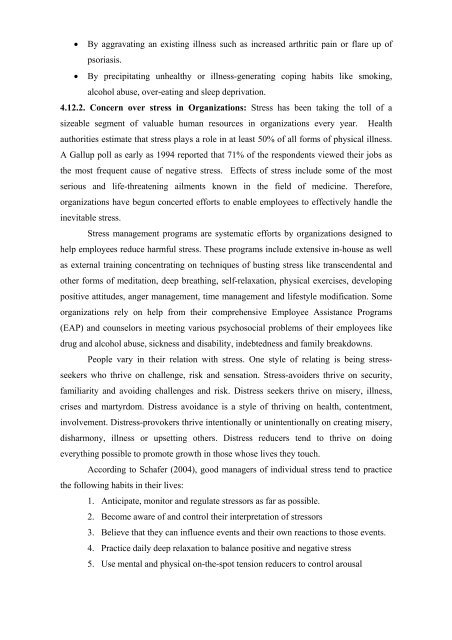UNIT – I Lesson 1 HRM – AN OVERVIEW Lesson Outline Nature of ...
UNIT – I Lesson 1 HRM – AN OVERVIEW Lesson Outline Nature of ...
UNIT – I Lesson 1 HRM – AN OVERVIEW Lesson Outline Nature of ...
You also want an ePaper? Increase the reach of your titles
YUMPU automatically turns print PDFs into web optimized ePapers that Google loves.
• By aggravating an existing illness such as increased arthritic pain or flare up <strong>of</strong><br />
psoriasis.<br />
• By precipitating unhealthy or illness-generating coping habits like smoking,<br />
alcohol abuse, over-eating and sleep deprivation.<br />
4.12.2. Concern over stress in Organizations: Stress has been taking the toll <strong>of</strong> a<br />
sizeable segment <strong>of</strong> valuable human resources in organizations every year. Health<br />
authorities estimate that stress plays a role in at least 50% <strong>of</strong> all forms <strong>of</strong> physical illness.<br />
A Gallup poll as early as 1994 reported that 71% <strong>of</strong> the respondents viewed their jobs as<br />
the most frequent cause <strong>of</strong> negative stress. Effects <strong>of</strong> stress include some <strong>of</strong> the most<br />
serious and life-threatening ailments known in the field <strong>of</strong> medicine. Therefore,<br />
organizations have begun concerted efforts to enable employees to effectively handle the<br />
inevitable stress.<br />
Stress management programs are systematic efforts by organizations designed to<br />
help employees reduce harmful stress. These programs include extensive in-house as well<br />
as external training concentrating on techniques <strong>of</strong> busting stress like transcendental and<br />
other forms <strong>of</strong> meditation, deep breathing, self-relaxation, physical exercises, developing<br />
positive attitudes, anger management, time management and lifestyle modification. Some<br />
organizations rely on help from their comprehensive Employee Assistance Programs<br />
(EAP) and counselors in meeting various psychosocial problems <strong>of</strong> their employees like<br />
drug and alcohol abuse, sickness and disability, indebtedness and family breakdowns.<br />
People vary in their relation with stress. One style <strong>of</strong> relating is being stressseekers<br />
who thrive on challenge, risk and sensation. Stress-avoiders thrive on security,<br />
familiarity and avoiding challenges and risk. Distress seekers thrive on misery, illness,<br />
crises and martyrdom. Distress avoidance is a style <strong>of</strong> thriving on health, contentment,<br />
involvement. Distress-provokers thrive intentionally or unintentionally on creating misery,<br />
disharmony, illness or upsetting others. Distress reducers tend to thrive on doing<br />
everything possible to promote growth in those whose lives they touch.<br />
According to Schafer (2004), good managers <strong>of</strong> individual stress tend to practice<br />
the following habits in their lives:<br />
1. Anticipate, monitor and regulate stressors as far as possible.<br />
2. Become aware <strong>of</strong> and control their interpretation <strong>of</strong> stressors<br />
3. Believe that they can influence events and their own reactions to those events.<br />
4. Practice daily deep relaxation to balance positive and negative stress<br />
5. Use mental and physical on-the-spot tension reducers to control arousal
















